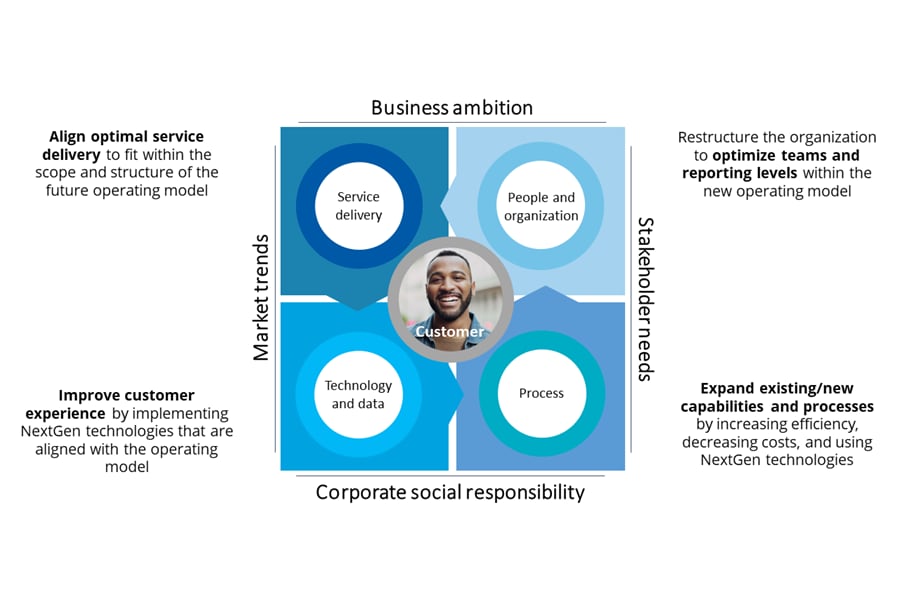Keeping the customer experience at the center of your operating model has been saved

Perspectives
Keeping the customer experience at the center of your operating model
COO Agenda
In today’s hyperconnected world, where customer expectations are at an all-time high, it is critical to put the customer at the center when designing your operating model. A customer-centric operating model is not just about developing products and services that meet customer needs; it is about transforming your organization’s capabilities by bringing together a mix of structural, process, and technology changes in a way that aligns to your strategic ambition and delivers the right experience for your target customers.
Explore content
- How should customers drive your organization’s operating model design?
- Change in action: Customer-driven operating models in banking
- Bringing enhanced capabilities to life
- Components of a NextGen operating model
- Which operating model elements should an organization focus on?
Deloitte research has shown that customers who enjoy positive experiences are likely to remain customers for five years longer and cost up to 33% less to serve.1 For organizations looking to make operating model improvements, this means it is essential to consider the specific needs and behaviors of their customers and the interactions shared with them.
How should customers drive your organization’s operating model design?
Organizations are interacting with customers through an increasingly wider and diverse set of channels and access points now more than ever before, and customers’ expectations are being influenced by highly personalized, novel experiences with innovative tech organizations and industry disruptors.2 In order to take advantage of every customer interaction as an opportunity to win their heart and mind, a new approach is needed.
As we introduced in our last article, winning operating models craft a lovable “front stage” customer experience when interacting with your organization, while simultaneously managing the “backstage” capabilities and sequence of activities to deliver on that experience.
Before translating your backstage capabilities into an executable operating model, it is critical to first understand the following about your target customer:
- Features and benefits of your product or service that create customer value.
- Behaviors, wants, and needs of the customers you want to attract.
- How customers access, experience, and interact with your organization across traditional and digital channels.3
Change in action: Customer-driven operating models in banking
In our last article, we shared typical differentiating capabilities based on an organization’s strategic ambition and operating model design archetype. Let’s look at operating model designs for two banks—one serving the mass market and one serving ultra-high-net-worth clients.
Both banks sought to offer differentiated products and services, aligning with the “Best Product” operating model archetype. This required them to focus on the select set of capabilities highlighted below. While both banks had a similar ambition, the expectations, needs, and preferences of their respective customers meant that these capabilities manifested in different ways:

* Selected capabilities are those typically prioritized for organizations that align to Deloitte’s “Best Product” operating model archetype.
Bringing enhanced capabilities to life
Once an organization has identified the capabilities needed to deliver the desired front-stage experience, it needs to consider how four operating model elements—service delivery, process, people and organization, and technology and data—come together to deliver the capabilities required.
Unlike siloed initiatives focused on a single element, winning operating models deliver new or enhanced capabilities in ways that optimize across all four elements. For example, building a bleeding-edge modern technology stack is not helpful if it’s not paired with redesigned processes and an organizational structure that takes advantage of real-time integrations to respond to customer requests more rapidly.

Components of a NextGen operating model
Which operating model elements should an organization focus on?
The changes required to an organization’s processes, people and organization, technology and data, and service delivery model are unique to each organization, based on its ambition, its customers, and the priority capabilities it has identified. What is consistent is the need to bring together an often-disparate set of organizational leaders to align on the optimum operating model design.
Making operating model design decisions consistently in a way that is aligned to your strategy and business model across these four areas requires discipline and thoughtfulness. Some of our lessons learned include the following:
- Changes to an organization’s operating model should be focused on enabling its business ambition within the context of the current and anticipated market environment.
- Consistently and rapidly making design decisions is important to maintain momentum. (This is where identifying a preferred operating model archetype and defining a set of commonly applied design principles can help align an organization’s leaders.)
- Understanding customers’ expectations and their desired experience is key as this informs prioritization of capabilities that will differentiate an organization from its peers.
- Transformational operating model changes combine service delivery model, processes, people and organization structure, and technology and data changes, and do not optimize for any one element in preference of another.
We have a range of industry-specific examples that demonstrate the value that a unified team with deep experience in process modeling, technology implementation, organizational design, and standing up shared services and outsourcing models can bring. To learn more about how clients leverage our years of hard-won knowledge and experience creating winning operating models, please reach out. We look forward to hearing from you.
Endnotes:
1.Craig Brabec and Beena Ammanath, “Inflation? Recession? Double-down on the customer experience, powered by AI,” Deloitte AI Institute, 2022.
2.Dr. Ahmed Hezzah and Hosein Moghaddas, “Elevating customer experience for the consumer products and retail industries,” Deloitte, November 2021.
3.Alek Pruziński et al., Customer Service Excellence 2023: European survey conclusions, Deloitte Digital, September 2023.
Building NextGen operating models for the future
Article 1: Why changing your operating model is necessary to remain competitive in today’s market
Article 2: So you’ve decided to evolve your operating model, what’s next?
Article 3: Keeping the customer experience at the center of your operating model
Get in touch
 |
Joe Alt Principal Operating Model Transformation Leader |
 |
Rob Kaye Principal Operating Model Transformation Leader |
 |
Brendan Houng-Lee Senior Manager Operating Model Transformation Leader |
 |
Michael Summerfruit Manager Operations and Technology Transformation |
Recommendations
Target Operating Model Design
Explore how organizations must navigate tradeoffs across capabilities in alignment with their target operating model design or risk getting lost in the crowd as they attempt to do everything .
Operations Transformation
Reimagine business operations consulting


